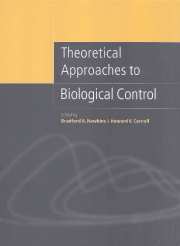Book contents
- Frontmatter
- Contents
- List of contributors
- Preface
- Part I Biological control theory: past and present
- Part II Ecological considerations
- 4 The uniformity and density of pest exploitation as guides to success in biological control
- 5 Biological control of insect pests: a tritrophic perspective
- 6 The case for indigenous generalists in biological control
- 7 Why is the parasitoid Encarsia formosa so successful in controlling whiteflies?
- 8 Parasitoid adult nutritional ecology: implications for biological control
- 9 Coexistence of multiple attractors and its consequences for a three-species food chain
- Part III Spatial considerations
- Part IV Genetic/evolutionary considerations
- Part V Microbes and pathogens
- Index
5 - Biological control of insect pests: a tritrophic perspective
from Part II - Ecological considerations
Published online by Cambridge University Press: 13 August 2009
- Frontmatter
- Contents
- List of contributors
- Preface
- Part I Biological control theory: past and present
- Part II Ecological considerations
- 4 The uniformity and density of pest exploitation as guides to success in biological control
- 5 Biological control of insect pests: a tritrophic perspective
- 6 The case for indigenous generalists in biological control
- 7 Why is the parasitoid Encarsia formosa so successful in controlling whiteflies?
- 8 Parasitoid adult nutritional ecology: implications for biological control
- 9 Coexistence of multiple attractors and its consequences for a three-species food chain
- Part III Spatial considerations
- Part IV Genetic/evolutionary considerations
- Part V Microbes and pathogens
- Index
Summary
Introduction
The success of classical biological control in providing spectacular examples of the impact that natural enemies can have on insect pest populations is rarely questioned. The introduction of the vedalia beetle from Australia for control of the cottony-cushion scale in California and the release of Apoanagyrus lopezi across central Africa for control of the cassava mealybug demonstrate that both predators and parasitoids can reduce damaging pests to innocuous levels of abundance (DeBach & Rosen, 1991). Successful biological control projects against insect pests have also proven, in a number of cases, to be repeatable in different geographic regions of the world and almost all truly successful projects have provided lasting control of the target pest (Clausen, 1978). It is obvious from the biological control record that some target pests are more suitable and more likely to result in further success than others. There have been more frequent successes in the control of homopteran pests than in any other taxon of insect pests (Clausen, 1978; Greathead, 1986; Greathead & Greathead, 1992) and so any general theory for the biological control of insect pests would do well to address the biological features of a crop–homopteran–natural enemy system. Despite the practical successes achieved in classical biological control, we have been rather less successful in developing a general theory for biological control and a mechanistic explanation for the effective top-down action of the natural enemies in successful biological control programs.
- Type
- Chapter
- Information
- Theoretical Approaches to Biological Control , pp. 89 - 102Publisher: Cambridge University PressPrint publication year: 1999
- 3
- Cited by

